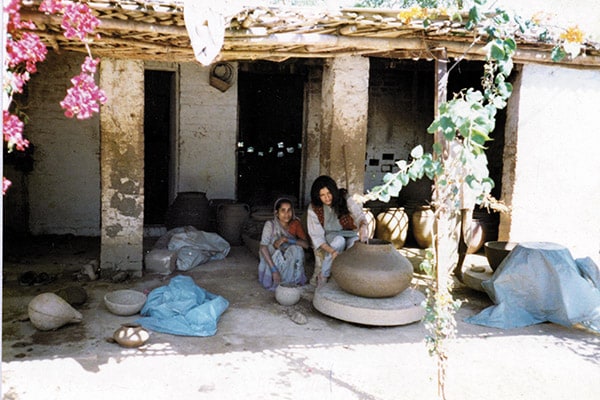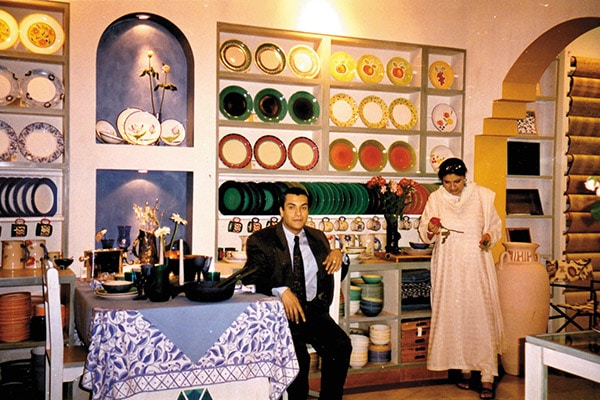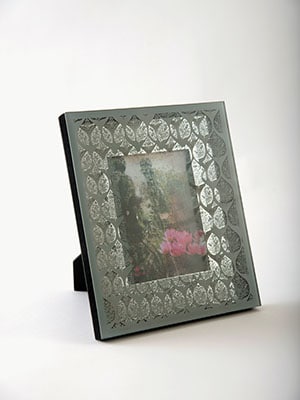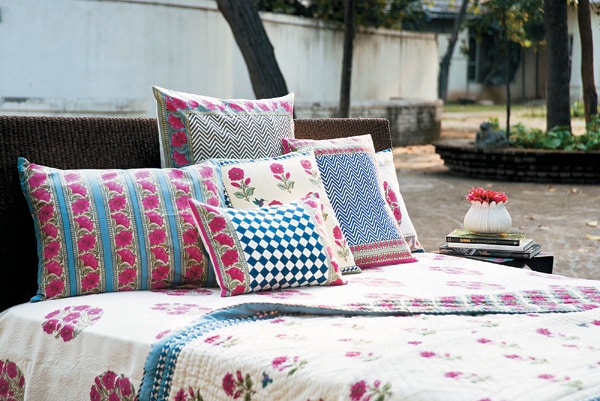A farmhouse makes for an unusual address for a corporate headquarter but, then, there is nothing about Tulsi Farms, or even its owner, that adheres to the usual. Shrouded in foliage and fenced in by heavy wrought-iron gates, the sprawling house squats on Mehrauli Road, Chhatarpur, in the outskirts of south Delhi. It is the heart and soul of homegrown luxury design house GoodEarth and mirrors the eclectic personality of its founder, 66-year-old Anita Lal. Anita’s office is a long, narrow room with a dining table at its centre. Her workspace is a small table devoid of accessories, unlike the walls which are lined with glass cabinets displaying GoodEarth’s extensive collection of crockery.
Anita, ForbesLife India finds, is immersed in conversation with some of her colleagues. “We don’t like the way our website looks. We are working on changing its design,” she says by way of explanation. As the impromptu meeting winds down, she adds, “I am in the office between noon and 5 pm to meet my colleagues. Otherwise, I prefer working from home.”
The farm—in another life it was a plant nursery—has been with the Lals for over three decades and holds a special place in Anita’s heart. It was here, as a young mother, that she started her creative journey and sowed the seeds for what would become one of India’s most popular home décor brands. “In the late 1970s, I started doing pottery here with local potters,” says Anita. She points to a large urn in the courtyard which she has kept as a memento. “I made that urn here, more than 35 years ago.”
When her son Siddharth was barely five and daughter Simran three, she enrolled with the Delhi Blue Pottery Trust, one of the country’s oldest and most prestigious pottery institutions. “I loved playing with clay,” she says. It was around this time that she met a potter who suggested she collaborate with rural artisans to try and make their work more contemporary. “Soon, I began working with Harikishan, a potter from Delhi. I brought him to this farm.” This was uncharted territory for both Anita and the potter, who was more familiar with matkas (pots), not large urns and jars.
Instead of purchasing pre-made pottery clay, she decided to create her own mix. “When we started out, our pots cracked and split,” she says. “By trial and error, though, we learnt to make perfect pots.”
By 1986, Anita had found her rhythm and started holding a few exhibitions at Delhi boutique Carma owned by her friend, art collector Lekha Poddar. It was Poddar who suggested she open a store at the Santushti Shopping Complex in Chanakyapuri, south Delhi. “In those days,” says Anita, “good crockery was not available in India. I used to source kitchenware for my house from Europe. It made sense to start a crockery and pottery shop.”![mg_77955_pottery_artist_280x210.jpg mg_77955_pottery_artist_280x210.jpg]() A young Anita at the Delhi Blue Pottery Trust with Mansimran “Mini” Singh, son of famous potter Gurcharan Singh
A young Anita at the Delhi Blue Pottery Trust with Mansimran “Mini” Singh, son of famous potter Gurcharan Singh
Anita set up a kiln at Tulsi Farms and roped in students from National Institute of Design (NID) to help paint the plates, cups, saucers and urns that were being created.
But there was a snag: Santushti didn’t allow renters to display pottery in the common area outside the shop. “I don’t recollect the exact details, but my store was small, about 1,000 sq ft, and some of the urns we sold were huge,” she says. This shop, named Tulsi, opened in 1989.
For Anita, this was not a business she saw it as a way to exhibit her work rather than make money. Seven years lapsed before she decided to launch GoodEarth in Kemps Corner, south Mumbai.
Like many events in Anita’s life—be it her whimsical decision to study pottery, or work with rural potters or open Tulsi at the suggestion of a friend—this venture, too, was pure serendipity. “A friend offered my husband (businessman Vikram Lal) the option of renting a 1,200 sq ft space in Kemps Corner to set up a Royal Enfield showroom. He didn’t want it. I told my husband that I would take it,” she recalls.
At the time, Vikram Lal was the chief executive and managing director of automobile company Eicher Motors (which manufactures and markets the Royal Enfield motorbike and is an equal partner in a joint venture with Volvo). It is part of the Eicher Group which includes Eicher Goodearth Pvt Ltd. Founded by Vikram’s father MN Lal, Eicher Goodearth Pvt Ltd manufactured and sold tractors today, it owns the GoodEarth stores, Eicher Maps and Eicher Goodearth Publications. Vikram and Anita’s son Siddharth heads the family business now.
Anita took out a lease for the Kemps Corner property in 1995 and opened the store a year later. For a new name, she dug into family tradition for inspiration. MN Lal had named his company after reading Pearl S Buck’s Pulitzer Prize-winning novel, The Good Earth (1931). “GoodEarth brings to mind earth, pottery and nature,” she says, of her decision to christen the brand GoodEarth.
With the group of NID designers, who have remained with her to this day, she put together a range of products, mainly crockery. The trusty kiln at Tulsi Farms was fired up again. “We hand-painted plates, shipped them to Mumbai and put together a beautiful shop.” This time, though, Anita also sourced select products from local Indian manufacturers.
She laughs as she remembers watching Dilwale Dulhania Le Jayenge (1995) with the NID students at Maratha Mandir theatre in Mumbai. “The film was released when we were working towards GoodEarth’s launch, and it’s still running there after all these years.”
Unlike most entrepreneurs who struggle to get their business on an even keel, funding did not weigh too heavily on Anita’s mind. She had her husband’s complete support: The holding company, Eicher Goodearth, would bail out her business whenever it was short on funds. There are no investors: This gives Anita the luxury to focus on the brand rather than on revenues. “Every year for the first five years, I would hold out a borrowing hand to our holding company whenever I ran out of money. We are so proud that we don’t need to do that anymore,” she says.
GoodEarth was able to break even after 10 years of operation in 2006 it became profitable two years ago. Today, it has nine outlets across Mumbai, Delhi, Chennai, Bangalore and Hyderabad, and an international presence with two stores in Singapore and one in Turkey’s capital, Ankara.![mg_77957_goodearth_store_280x210.jpg mg_77957_goodearth_store_280x210.jpg]() Anita Lal with Ravi Abraham, one of her first designers, at the launch of the Kemps Corner outlet in 1996
Anita Lal with Ravi Abraham, one of her first designers, at the launch of the Kemps Corner outlet in 1996
What Anita didn’t realise was that GoodEarth would become a full-time commitment. “I had jumped in without a plan,” she says. And was unprepared for the way events unfolded. “For instance, I had painted colourful chillies on a range of crockery. It became very popular.”
The store’s popularity and the media coverage was a pleasant surprise given that she was a “complete novice” at business. She had majored in psychology from Punjab University and was convinced that if she ever pursued a career, it would be as a psychologist or counsellor. Instead, she was introduced to business concepts such as merchandising and warehousing which were quite alien to her. She doesn’t dwell much on the hard work that the business demanded. “It took a lot of heartbreak and effort to create the first store,” says Anita, who credits her daughter Simran for the company’s current success. “She is the CEO, and has turned it (GoodEarth) into a big business.”
She may have begun with chilli-painted plates but, over the 18 years since its inception, her company has expanded to include categories such as linen, aromatherapy, home decor items and bed and bath accessories.
As she continues to reminisce about the old days, she is interrupted by the head of the apparel division who shows her a red cotton sari which Anita had said was too coarse. “I had asked them to soften it. Doesn’t it feel so much better now?” she asks as she runs her fingers through the fabric.
This is a recent addition to GoodEarth’s porfolio: The apparel collection—launched three years ago—caters to women and is the fastest-growing division in the company. Like the rest of its products, its kurtas, sarees, salwars and Indo-Western wear are a celebration of Indian art and craft. The company works with craftsmen from different states but adds a contemporary feel to the designs. “I don’t want people to buy my clothes as charity. I want khadi and other traditional wear to become aspirational,” she says.
The store retails handwoven Chanderi and Varanasi saris its Assam silks display the north-eastern weave of Ryndia and her latest collection makes liberal use of Ikat and Batik prints and natural indigo dyes. As she walks through the design studio, she spots a swathe of cream fabric and asks Asha—a designer who has been with her from the beginning—to turn it into a dupatta. Impromptu suggestions such as these are a part of everyday work for Anita. When in office, she spends her time brainstorming with colleagues on design and product categories. “I don’t bother about the business side of things. I have left that to my daughter,” she says.
“My real passion is anthropology and archaeology, but, to do anything big in those fields, you need a PhD,” says the 43-year-old Simran, who joined her mother’s business in 2002 as head of retail. “So I dropped that idea and joined GoodEarth.” She did her BA in history from Delhi University, after which she completed her Masters at Bangalore University. Simran decided not to pursue a life in academia and headed to New York City to study product design at the Fashion Institute of Technology. She also took a few courses in museum design and anthropology before returning to India.
While GoodEarth was familiar territory for Simran, managing its retail side was a steep learning curve. “The part that comes naturally to me is design, but as mom was heading that, I began handling everything else,” she says.
By 2002, GoodEarth had three stores in India: Two in Delhi, at Qutb and Santushti, and one in Kemps Corner, Mumbai. Each outlet oozed decadence and luxury, something the Lals are particularly focussed on. Every store was meant to be a symphony of products that work together to tempt the most apathetic buyer.
Both mother and daughter insist that GoodEarth is a philosophy. And strive to manifest that in their stores. Anita oversees every design aspect of the outlets. She even compiles playlists for the music. The theme varies every month during the 2014 FIFA World Cup in June, it was a month of Brazilian music. July recalled lazy rainy days. “I didn’t want the usual techno music that stores play,” says Anita, who is an Elvis Presley fan.
This attention to detail has borne fruit. “By the time I joined, my mom had turned GoodEarth into a great brand,” points out Simran. But she was also “a little stuck”, she adds. “So I said, ‘Let’s look at a new store in Mumbai’.”
Anita remembers that time very well. “I was at the Kemps Corner store when Simran told me that we should look at Raghuvanshi Mills. A regular customer at the store overheard our conversation and warned Simran that GoodEarth should stay personal even if it grew big. I promised him that I would never make it impersonal and, to this day, he remains a good friend and customer,” she says.
Simran bought a 20,000 sq ft property at Raghuvanshi Mills and, in 2005, the iconic GoodEarth store in Lower Parel was born. It was the daughter’s brainchild, a labour of love and a dedication to the company her mother had built. It was also a canny business decision the revamped mills complex was fast becoming an interior design and decor hub. (The Kemps Corner outlet was shut down since it was too small to meet their growing requirements.)
![mg_77961_photo_frame_280x210.jpg mg_77961_photo_frame_280x210.jpg]()
The space Simran bought was originally a mill with high ceilings and “old pillars that date back to 1857” (the year of the Sepoy Mutiny). And if rumours are to be believed, it even has a ghost or two haunting it, she says. According to Simran, products left at a particular spot would be displaced to another part of the store at night. It’s the “ghosts of Raghuvanshi”, she smiles.
“The place was in shambles, but we loved it. I had envisioned a good cafe there and we have one now, The Tasting Room. It’s a magical place,” says Simran, who relocated to Mumbai for eight years to run the new store.
The city was kind to her. After all, she met her husband Raul Rai at GoodEarth, Raghuvanshi. “He had returned to Mumbai to work for a private equity firm after spending 18 years in New York. He frequently visited GoodEarth to buy things for his home,” she says. Rai asked her to marry him within two days of them meeting. “I did not accept,” she says, but his perseverance paid off and they got married in 2007. Simran left Mumbai and bought a house in East Nizamuddin, New Delhi, where she lives with Rai and her two sons, aged five and six. Her husband currently works with Eicher Goodearth, but the entrepreneur will be starting his own business soon.
Through romance and marriage, Dilwale Dulhania Le Jayenge and ghosts, children and family, GoodEarth slowly grew into a structured business. Anita’s son, Siddharth, who is managing director and chief executive of Eicher Motors Ltd, played a pivotal role, too. He pushed the company (and his mother) to hire international consultant and financial services company, Mercer, to study GoodEarth’s structure.
“In its initial years, the business didn’t have a CEO. Mom was the de facto head, but she wasn’t doing the job expected of the role. We had an operations head, but that person wasn’t CEO material either,” says Simran. Mercer recommended that GoodEarth hire a dedicated chief executive to run the company, a role that was handed over to Simran in 2011. “I got arm-twisted by my family into saying yes,” she laughs, recalling that she had only just rejoined the company after a two-year maternity break.
As of this financial year, GoodEarth is a Rs 120-crore company with profit margins of 10 percent, and 600 employees. “This happened only because of Simran and Siddharth. My colleagues would always tease me that GoodEarth would never become profitable under me,” says Anita. (Siddharth is on the company’s board and has been advising his mother for the past five years.)
When GoodEarth made a profit for the first time in 2012, everyone was excited about it and started setting ambitious targets. Anita wasn’t happy and called for a meeting with the management. “Managers get driven by numbers and then you start taking shortcuts. Pressure starts mounting. I made GoodEarth into a design-led company and I want to keep it like that,” says Anita, adding that the biggest danger to a brand is when it is successful.
Her children, however, admit that the company lacked discipline and direction. Simran introduced processes and charted out a business strategy. She quickly realised that there was a disconnect between the operations arm of the company and the retail staff in the front-end. She asked the retail staff to take note of customer feedback and relay it to the operations team. This way, consumers would know that GoodEarth was listening to them, she says.
Through it all, Tulsi Farms remains the nerve centre. “You can’t put people in barracks and expect them to work,” says Anita.
For most part, the mother and daughter speak the same language when defining GoodEarth’s vision. They agree that the brand comes before growth. Simran has followed Anita’s philosophy to a point and has made it clear to the front-end staff that if they achieve their targets at the cost of the brand, it wouldn’t be celebrated. “It is the key role I play with AL [that’s how she addresses her mother]. You have to step back and re-examine everything. There should be some disruption in business,” says Simran. The two may not always be on the same page. “But the advantage of being mom and daughter is that we can sit and chat on the bed. There’s an openness between us,” says Anita. Her daughter agrees that they have found a balance.
“We fight, but we work it out.”
With Simran at the helm, expansion is on the cards, and her gaze is trained towards international markets which contribute to half of the company’s sales. Customers from countries such as Mexico, Japan, Chile and South Africa have been buying GoodEarth’s products from its website. There are plans to increase the physical presence abroad. “We have to get the supply chain in order and we will open in either London or New York.” Powering up the retail arm and increasing online business is also a priority. “Our focus is to create a web boutique (that’s what GoodEarth calls its website),” she says.
Meanwhile, Anita is busy doing what she does best and enjoys most: Putting together the annual Diwali theme. When she first started on this journey, almost all the products had a personal touch. But to keep up with demand, designers and craftsmen now hand-paint master templates on paper. The designs are sent from Tulsi Farms to the company’s factory in Ballabgarh, Faridabad. The crockery collection, for instance, has moved from pottery to factory-made products, but artisans are roped in for textiles and metal work.![mg_77963_designing_bedsheet_280x210.jpg mg_77963_designing_bedsheet_280x210.jpg]() Linen from the ‘Java Kusma’ range draws inspiration from the hibiscus
Linen from the ‘Java Kusma’ range draws inspiration from the hibiscus
Every year, during the festive season, GoodEarth celebrates traditional and forgotten craft through a geographically themed collection. The aim is to revive and upgrade India’s dying craft ecosystem. “The children of Indian craftsmen don’t want to continue the tradition because it doesn’t pay well,” says Simran, who wants to rectify this. (GoodEarth never negotiates with traditional artisans.)
This year, the brand has taken on an international motif, ‘Silk Route’. Designers travelled to Fergana and Samarkand in Uzbekistan for inspiration. Anita, who heads the design team of 20 core members, chooses a theme with a cultural resonance to India. She often draws her inspiration from the books she loves. Alexander Frater’s Chasing the Monsoon and Raiders from the North: Empire of the Moghul by Alex Rutherford are old favourites. Past Diwali themes have included the ‘Gardens of Kashmir’ and ‘Vrindavan to Deccan Golconda’. (It’s around this time of the year that Simran wistfully wishes she was more involved in creating the look and feel for GoodEarth.)
Her mother, meanwhile, is considering an Indo-Pak theme, given that her family came from Lahore. “I wasn’t born there, but I treasure the memories that have been handed down from generation to generation,” she says, as she gets ready to return to her house in Chanakyapuri, south Delhi. It’s 5.30 pm. Once home, she will continue to work, “at times till 3 am”. “I have no life except for work,” says Anita, who avoids socialising except with close friends.
Simran, for good reason, is amused when people ask her if her mother is involved in the business. “This is her baby and she is one hundred percent involved,” says Simran. “She is the founder and she is the soul. I only help the soul find its right avatar.”

 A young Anita at the Delhi Blue Pottery Trust with Mansimran “Mini” Singh, son of famous potter Gurcharan Singh
A young Anita at the Delhi Blue Pottery Trust with Mansimran “Mini” Singh, son of famous potter Gurcharan Singh Anita Lal with Ravi Abraham, one of her first designers, at the launch of the Kemps Corner outlet in 1996
Anita Lal with Ravi Abraham, one of her first designers, at the launch of the Kemps Corner outlet in 1996
 Linen from the ‘Java Kusma’ range draws inspiration from the hibiscus
Linen from the ‘Java Kusma’ range draws inspiration from the hibiscus